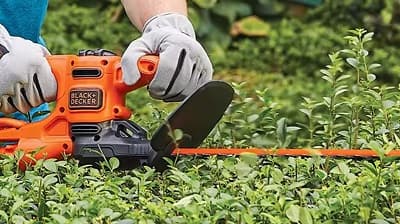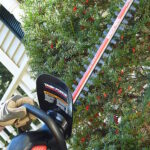As an Amazon Associate, this site earns commissions from qualifying purchases. For more information click here.
A hedge trimmer is an important garden tool for maintaining shrubs and hedges. Over time, sap and other residues will accumulate on the blade and make it difficult to use. By cleaning the blade, you can increase its efficiency. In this article you will learn the proper way to remove sap without damaging your hedge trimmer.
Dip a piece of rag in a lubricant and wipe the blade. Once the sap is removed, use another piece of cloth to wipe the blade dry. Always clean hedge trimmer blades outdoors to avoid inhaling the chemicals.

How to Remove Sap from Hedge Trimmers
Sap is sticky but getting it off a hedge trimmer blade is not that difficult. First you should prepare the following. These instructions are applicable for gas, electric and battery powered hedge trimmers.
Required Tools and Materials
- Hedge trimmer (Greenworks 24V cordless weed eater is our preferred choice)
- Work gloves
- Safety glasses
- Cleaning rag or sponge
- Stiff bristled brush
- Soapy water
- Face mask (optional)
- Solvent, turpentine or blade cleaning solution
There are a lot of blade cleaning products available. WD40 is widely used for example. If you use a Stihl hedge trimmer you may want to check out Stihl’s own blade cleaner. Check if your trimmer brand sells its own cleaning solution. If not, there are others available.
Step 1
Wear work gloves and safety glasses. The gloves are necessary since you will be cleaning the blade. You should also wear safety glasses so the cleaning solution does not accidentally get into your eyes.
The face mask is optional but strongly recommended. Some people are comfortable using solvents, turpentine etc. without any mask, but others are not. To be on the safe side you should wear one.
Step 2
Turn the hedge trimmer off. If it is electric, turn the switch off and disconnect from the power source. If the trimmer is battery powered, shut it off and remove the battery pack.
Bring the hedge trimmer outdoors. Never clean these power tools indoors as you will be using solvents and other chemicals. Always clean garden tools outdoors where there is good ventilation.
Step 3
Remove the blade from the hedge trimmer. You might need to unfasten some screws first. This guide can help you. Set the hedge trimmer body aside for now. If the rest of the tool is dirty too, you can clean it later. Or you can clean it now and the blade later.
Step 4
Which cleaning method you use depends on how much sap there is on the blade. If there is only a bit of sap, use a wire brush to remove it. Dip a rag or sponge in soapy water and wipe the blade. Allow the blade to dry naturally or wipe it dry with a clean rag.
If you got rid of the sap, your job is done. If the sap is still sticking to the blade, go to step 5.
Step 5
Get a piece of cloth and dip it into WD40, turpentine, solvent or another blade cleaning solution. Wipe the blade thoroughly. Dip the rag again into the cleaning solution if necessary. How often you do this depends on how dirty the blade is.
Step 6
Once all the sap is removed, get another piece of rag. Dip it in water and wipe the blade. Next, wipe the blade dry. Apply lubricant to the blade. You may want to apply Fluid Film on the blade too. This does not remove sap, but it prevents sap from sticking.
Step 7
Reattach the blade to the hedge trimmer. Reinstall the battery and turn it on. If it is electric, plug the cord into a power outlet and turn it on.
Tips and Warnings
There are a lot of blade cleaning products available. General, all-purpose blade cleaners will get the job done. We like Trend Clean 500 because it works fast and with all kinds of blades.
A wire brush coupled with a citrus based cleaner will get rid of sap too. If the sap is really sticky and there is a lot of gunk, you may try acetone or other solvents. Methyl ethyl ketone is particularly effective on stubborn sap and other residues.
Exercise caution when using solvents because these are flammable. If you have gas hedge trimmer, make sure you detach the blade and the main body with the fuel is placed far away.
If you are not sure which lubricant to use, consult your owner’s manual. As stated earlier, the major hedge trimmer makers sell their own blade cleaners. If you want to ensure nothing happens to the blade, buying from the same brand is the safe option. If the manufacturer does not sell blade cleaners, most general purpose lubricants will be fine.
No matter which lubricant you choose, a wire brush is a must. Even when you apply lubricant to the blade, brushing residue off is still necessary. This usually takes just a few minutes though.
How Often Should You Clean a Hedge Trimmer Blade?
Hedge trimmers should be cleaned after each use. This prevents sap, leaves, dirt and other materials from clogging the blade. Sap is harder to remove when dry so you should get rid of it as soon as possible. This also applies to dirt and other debris that could stick to the blade.
If you don’t clean the blade often, dirt will accumulate. The blade will be vulnerable to rust. Cordless hedge trimmers will stop working if the blade is too dry for example. This is also true for electric and gas models.
As this video shows, cleaning a hedge trimmer blade is easy. The process is similar for other brands so you can follow the example given here.
After each use, dip a rag in soapy water and wipe the blade. Wash with water and dry it. Apply lubricant and that’s it, you are done. And if you do this regularly, sap and other residue will not have a chance to build up. This means blade cleanup and maintenance will be quicker.
It is important that you lubricate the blade after removing sap. It is not enough to just wash the dirt off. Lubrication prevents the blade from drying, getting stiff and brittle.
Frequently Asked Questions
What lubricant is best for hedge trimmers?
Silicone spray lubricants are effective in removing sap and other grime from a hedge trimmer. These sprays also have anti-corrosion properties and can prolong the blade’s lifespan. Machine oil and most lubricants will work as well. Given a choice, silicone spray lubricant is the one you should get, and there are many available.
Is WD40 good for hedge trimmers?
Most people use WD40 on hedge trimmers without any problems. Some say it is not as effective on any equipment that produces heat, but majority have no issues with it. Unless the manufacturer specifically says not to use WD40, there ought to be no problems.
Is diesel a good hedge trimmer lubricant?
Diesel itself is not going to damage the blade, but you should avoid it for two reasons. One, it is not a potent lubricant. It does not prevent rust as well as other solutions and solvents. Second, diesel can be fatal to plants.
If you apply a small amount of diesel, it might not harm your plants. But it is already a weak lubricant so applying a small amount will not help the blade. It is better to use another lubricant instead.
Can You Use Vegetable Oil on a Hedge Trimmer?
Yes, vegetable oil and cooking oil can be used to lubricate hedge trimmer blades. It is milder compared to other cleaners so it will not cause damage. However, it is not as efficient in term of rust prevention. What you can do is apply vegetable oil along with your main lubricant as added protection.
What happens if I do not lubricate hedge trimmer blades?
The blade will turn rusty and become difficult to use. For this reason you should always apply lubrication when performing maintenance.

I love the outdoors and all the tools for maintaining gardens, yards and lawns. The only thing I am more passionate about is sharing what I know about garden and outdoor equipment.


